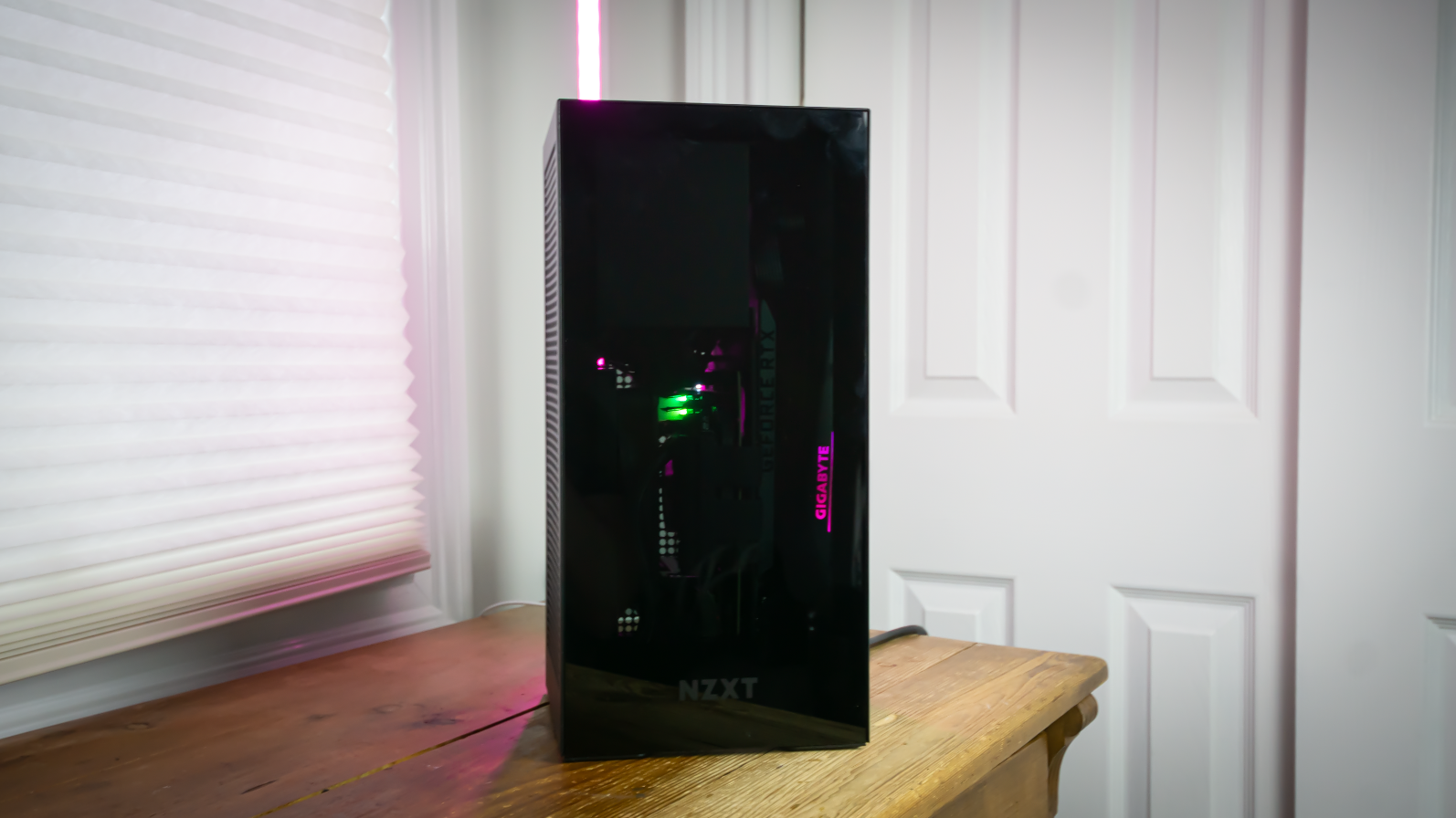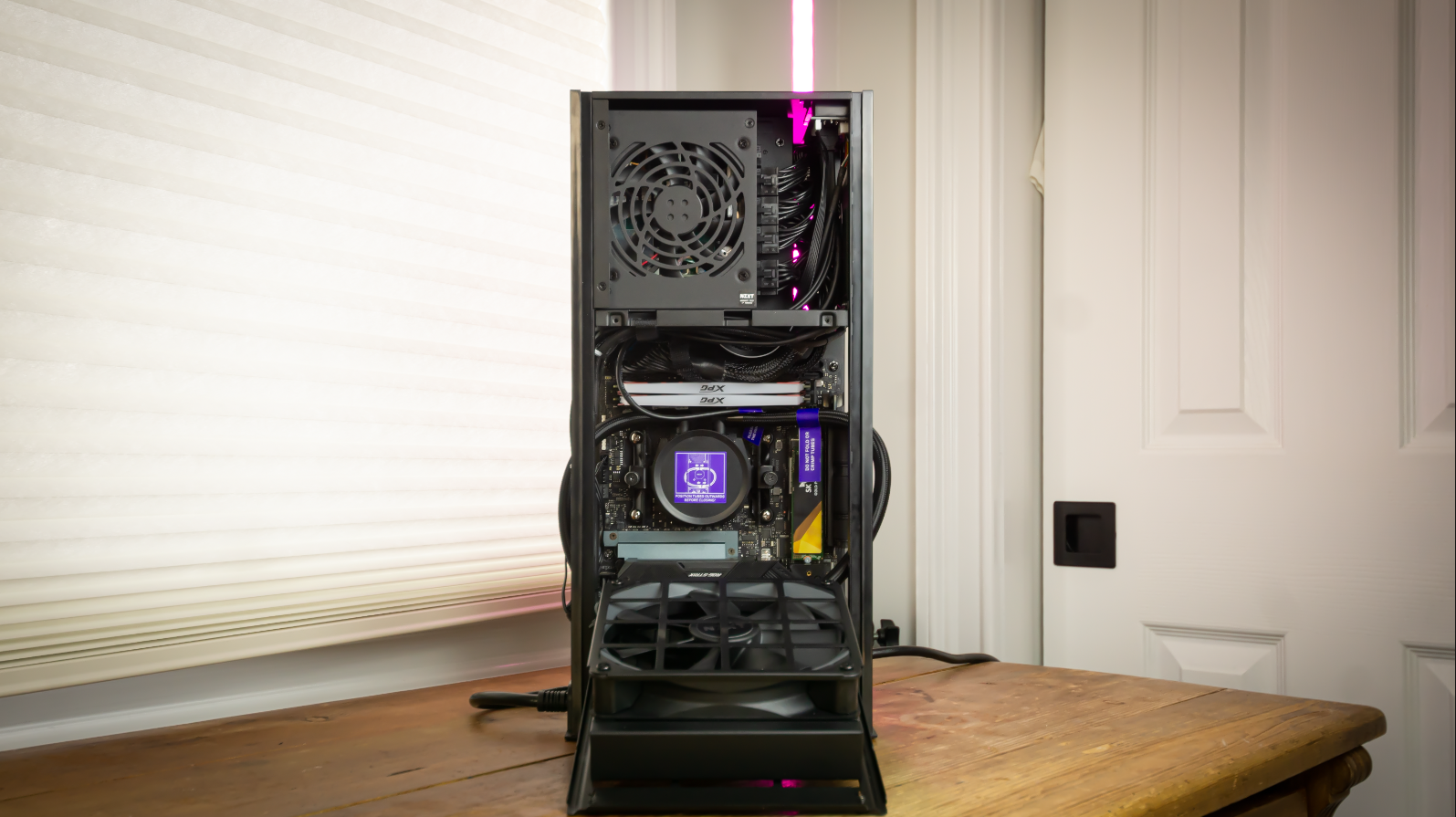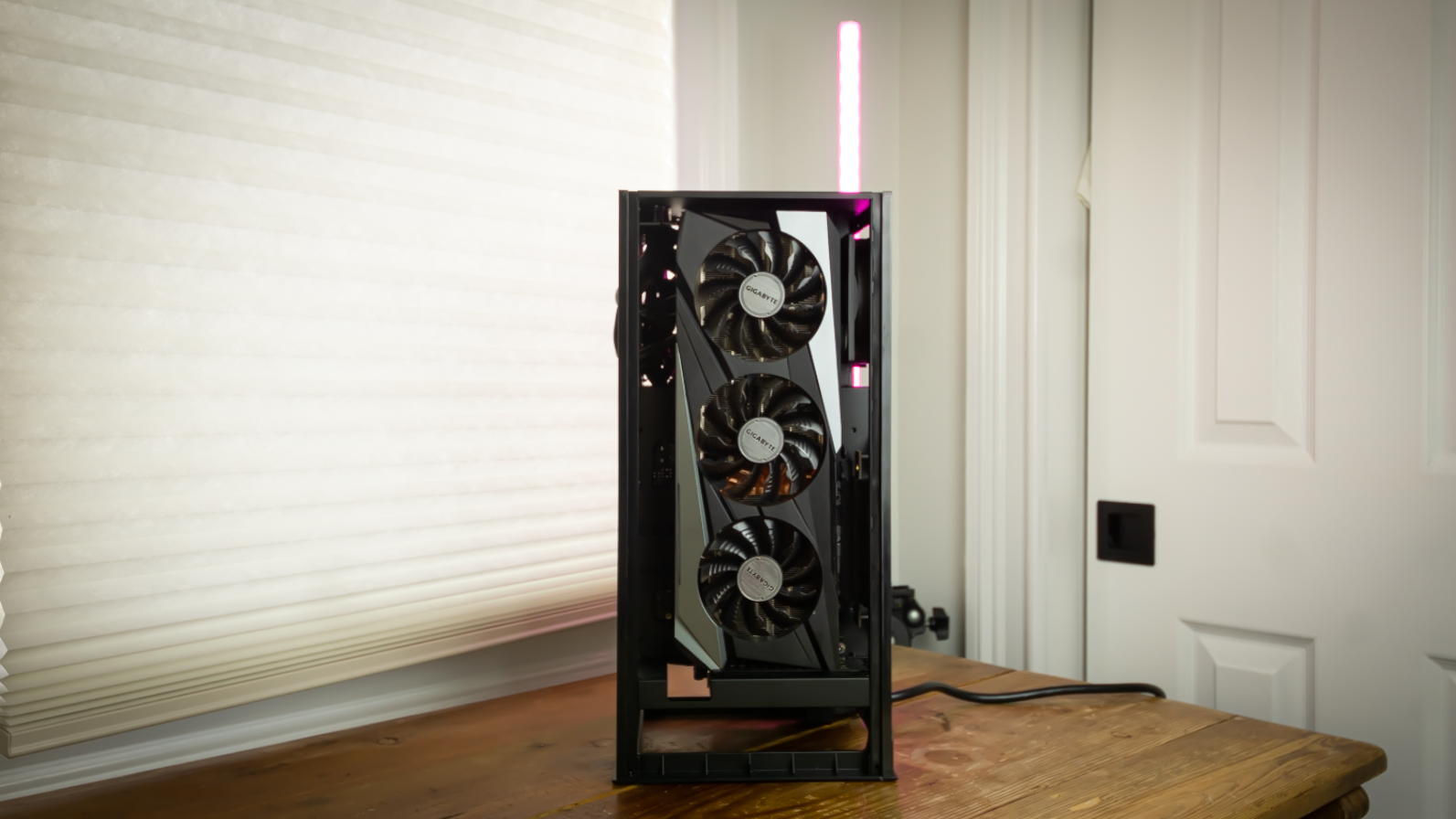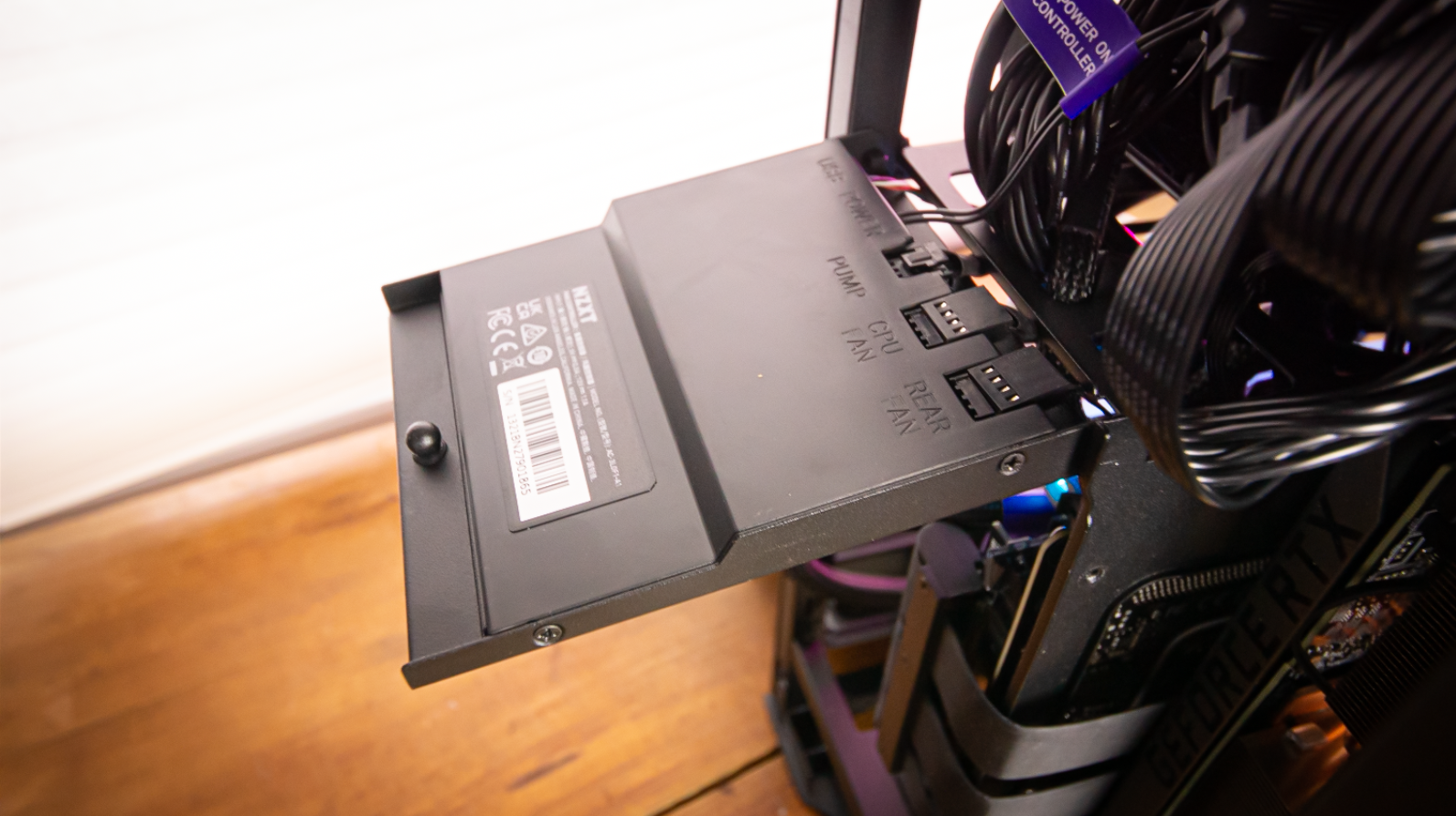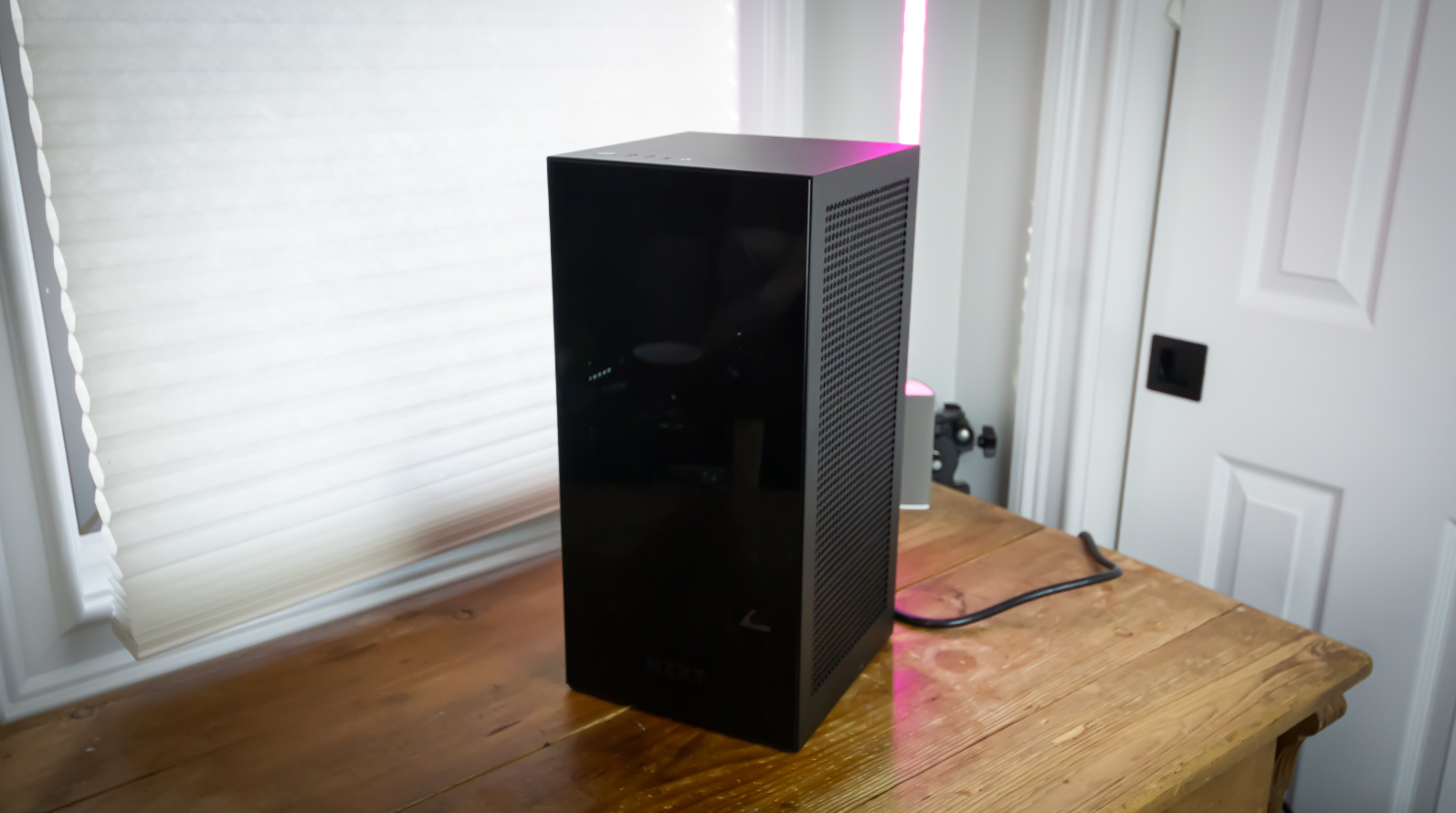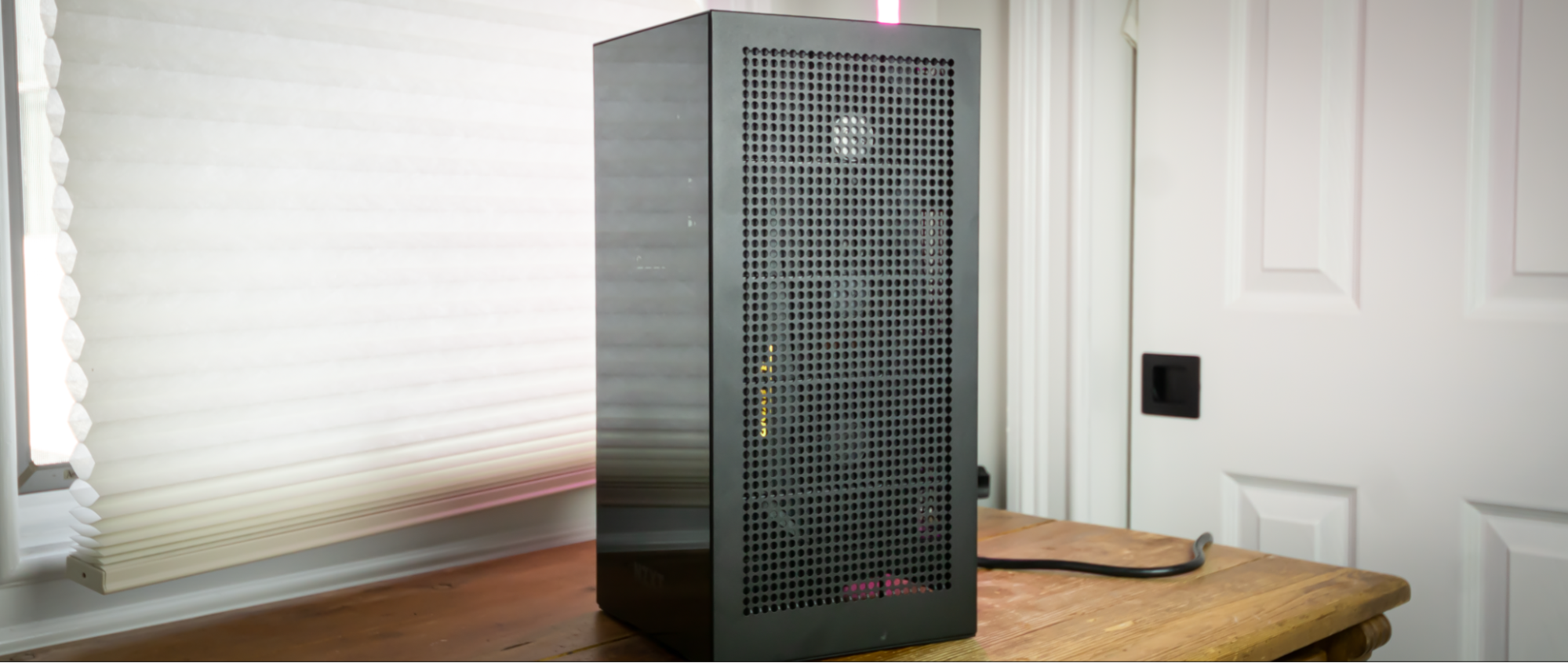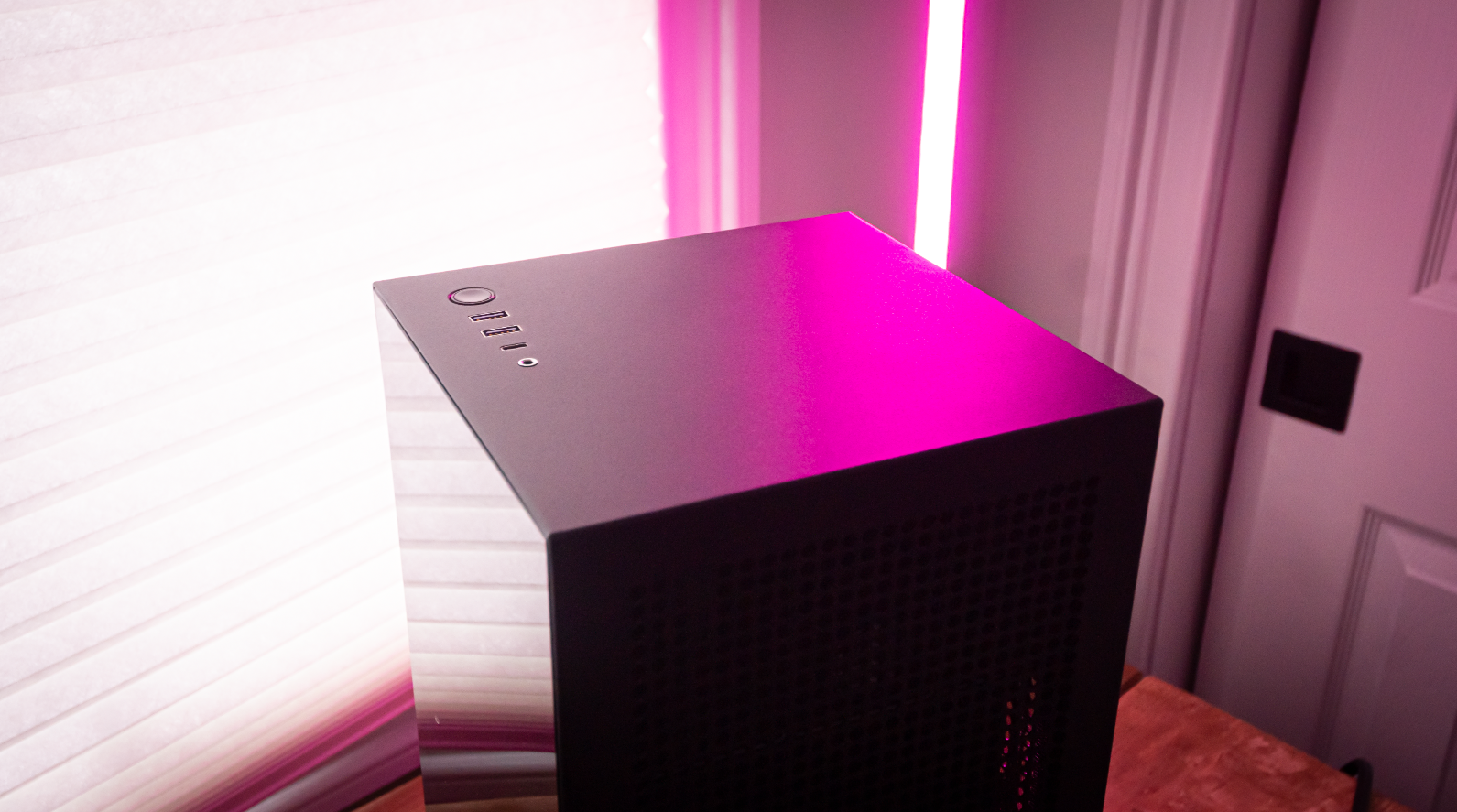Tom's Hardware Verdict
The NZXT H1 V2 is a decent compact case for builders who want minimal setup hassles, thanks to its included and pre-installed PSU and AIO cooler. But it’s expensive for what you get, GPU thermals aren’t great, and we had issues with the power supply on our first review unit.
Pros
- +
+ AIO cooler and PSU included
- +
+ Solid steel construction
- +
+ Pre-routed cables
- +
+ Quiet under full-load
Cons
- -
Expensive
- -
Thermal performance is just OK
- -
Our first review unit had PSU problems
Why you can trust Tom's Hardware
Small form factor PCs have become increasingly popular in recent years, especially with the PlayStation 5 and Xbox Series X/S consoles proving a capable gaming rig doesn’t have to be huge. This had led many PC enthusiasts to attempt to build the most epic ‘Console Killer!’ The thing is that fitting high-end hardware into a small case and keeping it all cool is easier said than done.
One of the more popular console-like small form-factor (SFF) cases, the NZXT H1, is back with an updated H1 V2 version that brings minor changes to make it more friendly to today’s big, power-hungry high-end GPUs. It also aims to right the wrongs that plagued the original model, causing it to be recalled due to a fire hazard just about a year ago.
Since many gamers are looking for that perfect HTPC case or console killer chassis, we need to see if the new H1 can compete with the cases on our Best Mini ITX Cases list. At $400, the H1 is certainly expensive, though it does come with an included 750-watt SFX PSU and AIO CPU cooler. But it faces stiff competition from the likes of Hyte’s Revolt 3. That case is a couple inches deeper front to back, and it doesn’t have a glass panel or an included cooler. But as of this writing, it was selling for just $200 with a 700W SFX power supply of its own.
The H1 V2 will be available in black or white, and should be available in Asia and Europe today. It’s expected to land in US stores a bit later, on February 21st. After the problematic recall of the first iteration of this case, did NZXT come back strong with the V2? Let’s dig in and find out.
NZXT H1 V2 Specifications
| Type | Mini-ITX |
| Motherboard Support | Mini-ITX |
| Dimensions (HxWxD) | 15.94 x 7.7. x 7.7 inches |
| Max GPU Length | 12.7 inches |
| External Bays | X |
| Internal Bays | 2x 2.5-inch |
| Expansion Slots | 2 |
| Front I/O | 2x USB 3.2 Gen 2 Type-A, 1X USB Type-C |
| 3.5mm headphone/audio jack | |
| Reset switch | |
| Other | 750W SFX PSU, Tempered Glass Side Panel |
| Front Fans | None |
| Rear Fans | 1x 92 mm |
| Top Fans | None |
| Bottom Fans | None |
| Weight | 16.7 pounds |
| Warranty | 3 years case, PCIe Riser and AIO, 10 years PSU |
Features of NZXT H1 V2
Since this is the second version of the H1, changes were made to the case to make it more practical. NZXT has added a 92 mm exhaust fan to the rear of the case for cooling, whereas the first version didn’t ship with any fans save for the one on the AIO radiator. The chassis is now slightly taller and wider, increasing maximum graphics card size from 12.01 inches (305 mm) on the original to 12.76 inches (324 mm) on the V2 to allow longer graphics cards.
However, the case is still tiny. I don’t have experience with the original H1, but the H1 V2 stands at just 15.9 inches tall and takes up 7.7 x 7.7 inches of desk space. The first version’s dimensions were 15.2 x 7.38 x 7.36 inches, so the size increase is far from substantial.
The included power supply is still an SFX 80 plus gold, but now it’s 750W, whereas the first was 650W. Again, this wattage increase is to accommodate today’s high-end graphics cards, and it’s certainly welcome. However, we encountered issues, which we’ll discuss later, with the power supply when testing.
Get Tom's Hardware's best news and in-depth reviews, straight to your inbox.
NZXT has always done things differently regarding airflow into the case. This is evident by the tempered glass front panels on its H-series cases. Because the H1 cools via intake from the sides, even a small case like this can have a tempered glass front panel. Note we said can, and not should.
The rest of the panels are composed of steel and are pleasingly thick. I have worked with cases that were so flimsy that when you’d handle them or screw fans into them, they would flex or wobble. That’s not an issue here at all.
The sides of the case feature the same airflow design that we saw on its bigger sibling: the NZXT H510 Flow. Yet, we saw this on the previous version of the H1, and when it comes to cooling, NZXT could benefit from a redesign.
The front of the case does feature a tempered glass panel that snaps right in, but I don’t understand its purpose. The glass panel is heavily tinted and seems forced. What I would like to have seen is another airflow panel instead.
The case IO is OK, but not anything to write home about; there are two USB Type-A ports, one USB Type-C connector and an audio jack on the top. The USB-C port supports 3.2 Gen 2, so it can connect at up to 10 Gbps if your motherboard supports it.
According to NZXT, the issue regarding the riser cable catching fire that plagued the V1 case has been addressed. NZXT even took the liberty of making this version PCIe 4.0 ready. In the interests of not setting our testing room ablaze, we didn’t attempt to inordinately stress the cable,; we just went about building a system in the H1 V2 as normal, and we never encountered any sparks or flames. But that doesn’t mean we didn’t run into issues related to power. More on that soon.
Internal Layout of NZXT H1 V2
Getting access to the inside of the H1 V2 is as simple as popping off the side panels and sliding the steel body off.
Have you ever looked at something and realized that it’s a lot roomier than it looks from the outside? That’s how I felt about the inside of the H1 V2. The main compartment or motherboard tray is covered by the included 140 mm all-in-one liquid cooler.
You access the motherboard tray by lifting the radiator, which is held in by two captive screws. To give you some perspective, it’s kind of like lifting the hood of a car, especially since, when it’s lifted, the motherboard is right there, just like an engine when you pop the hood.
Behind the motherboard tray is where your graphics card will connect via the included PCIe 4.0 riser cable. The H1 V2’s GPU chamber can house graphics cards up to 12.76 inches (324 mm) and 2.38 (58 mm) in width, which is fairly large. We installed a three-fan Gigabyte RTX 3070 TI Gaming OC for our testing and didn’t run into clearance issues.
The idea of giving the graphics card its own chamber in a case this small is smart, because it keeps it at least somewhat isolated from any heat dispersed from other components. However, NZXT’s approach to this could be improved. I’ll elaborate on that later on.
Underneath the case is where your motherboard’s IO, GPU and PSU connect, and I don’t like this at all. I’m able to give the power supply cable a pass since you’re probably going to plug it in and leave it. But video cables are often stiff, which can make the right turn necessary here a pain point for the cable, and any USB device swapping later on that you don’t want to plug into the top ports will mean having to lift up or tip down the whole case to plug things in.
Granted, this is a similar layout to many vertical SFF towers, including the Revolt 3 and the Ssupd Meshlicous. But there’s no denying you’re giving up a lot of convenience in terms of port access for the sake of a system with a small footprint. Just keep that in mind if you’re considering any of these cases.
The H1 V2 has just enough room for two 2.5-inch drives,which are stowed away in a little cage next to the SFX power supply. While this may not sound like much, you need to consider how much space a drive cage takes up. Plus, most ITX motherboards these days have connectors for more than one M.2 drive, so two additional drive slots are good enough for most modern builders looking specifically for a compact PC.
Cable Management on NZXT H1 V2
Cable managing any small form factor PC is a bigger chore than on any mid-tower chassis, due to the lack of cable room. The thing is, NZXT did a fantastic job by pre-routing the power supply cables on the H1 V2, which allowed me to connect to my motherboard without any extra tugging or twisting.
Because I wasn’t running with any SATA drives, I could tuck away the excess PCIe cables and whatnot into the SSD compartment. When I opened up the SSD compartment door, I was pleasantly surprised to see that this is where all of the fan cables were connected. I’m not exactly sure how, but NZXT was able to build its Smart Device V2 (a fan and RGB hub) into a door that covers your SSDs.
Another neat feature in the H1 V2 is the layout of the AIO. I love how the AIO’s tubes bow outward when this case is closed– it reminds me a lot of Cad Bane’s breathing tube from Star Wars.Did NZXT intend on having the tubes sit this way? I doubt it, but I like it.
It’s surprising to say that for such a small case that cable management was easier than some mid-tower cases. NZXT did an excellent job pre routing the cables to meet its motherboard connectors. I don’t even want to think of the horror show it must be to get the power supply seated with all of the cables attached, while dealing with the AIO. I’m happy NZXT does this for you, and it makes the case much more new-builder friendly.
To me at least, cable management within ITX cases isn’t as crucial (as long as it doesn’t block airflow) as it can be in a build that’s done in a standard mid-tower, so I’m overall impressed with the cable management on the NZXT H1 V2.
Cooling the NZXT H1 V2
One of the two pieces of extra component hardware that come with the H1 V2 is a 140 mm all-in-one liquid cooler. I understand that some people prefer air cooling over water cooling. Still, water cooling is arguably more practical here because of the case’s size. Plus, with a radiator oriented to exhaust, the heat from the CPU can be pushed out more efficiently than with an air cooler. This time around, NZXT includes a 92 mm exhaust fan to help expel any heat generated by the other components.
We are still waiting on parts for our new Mini ITX testbed, so in the interim we tested the H1 V2 with components we had at hand. The following acoustic and thermal results were performed using a Ryzen 5 2600X and a Gigabyte RTX 3070 Ti Gaming OC. Once we have the full set of new parts, we will re-run these tests for comparison with later reviews.
Acoustic Results for NZXT H1 V2
Our acoustic test consists of three scenarios: We run the CPU at full load, the CPU and GPU at full load, and an optimized mode. The CPU full load test runs the CPU and case fans at their maximum speed. For the CPU and GPU full load acoustic test, we also stress the Gigabyte RTX 3070 TI Gaming OC and set the fans at 75% speed, because in gaming the fans never run at 100 percent and are far too loud when they do.
For the optimized mode, we run the GPU fan speed at 30 percent and run the CPU and included case fans at their lowest speed.
| Optimized Mode | Case Full Speed | CPU & Case Full Speed, GPU 75% |
|---|---|---|
| 34dB | 40.8dB | 42.1dB |
The NZXT H1 surprised me a lot when it came to noise levels. For a chassis that’s composed mostly of thick steel with zero dampening materials at all, this case is hushed. Even when the GPU fans were ramped up to 75%, it was still bearable to my ears. I’m overall stunned and impressed with how well the H1 V2 dampens sound. This is likely one area where the glass helps.
Thermal Results for NZXT H1 V2
For the thermal tests, all case and CPU fan speeds are set to 100 percent. The AMD Ryzen 5 2600X is set at 4.1GHz. Letting the GPU run at 75% fan speed enables it to maintain its power target while sticking to one set of reasonable fan speed so that the temperature is the only variable.
| CPU Temperature | GPU Temperature | Average |
|---|---|---|
| 55 °C | 77 °C | 66 °C |
When we got to this part of our testing, our test system suddenly shut down. At first, I figured something overheated and the PC shut down. But when I tried to turn the system back on, nothing happened.
After hours of troubleshooting, installing the same parts in another system, it was clear that the power supply had died. Now, parts do occasionally die, sometimes when they’re brand-new due to manufacturing flaws or damage during some stage of manufacturing or shipping. Usually, we note this when it happens and warn potential buyers in the review, but don’t hold it against a company or product.
It’s usually hard to tell if we just got a rare defective part or if the issue is more widespread. That’s the case here as well. But given the fact that the previous H1 was recalled due to an electrical issue, it’s hard not to worry at least a bit when the followup case has its power supply randomly expire just a few hours into active use.
I notified NZXT and the company shipped us a new case. We started the testing over and the PSU in our second H1 V2 review unit worked fine–and is still working without issue as of this writing. Still, given the history the H1 line has, it’s hard not to see a random PSU failure as a red flag.
At the very least, if you opt for the H1 V2, you’ll want to do some stress testing while you’re still in the return window. NZXT does provide a generous 10-year warranty for the power supply, but no one wants to sit around waiting for an RMA with a bunch of PC parts they can’t use until a replacement power supply shows up.
Getting back to the thermal tests, the included 140 mm AIO did a fantastic job keeping our CPU chilled, at 55 degrees Celsius. However, our GPU’s thermals were not great at 77 degrees C, which surprised me since it has its own chamber to cool down in. At the same time, I’m not that surprised because it's not the ideal airflow design if you look at the side panel’s perforated design.
The case’s holes are too far apart to be ideal for airflow. We were still able to hit our power target, but I needed to bump up the temperature limit in MSI Afterburner to 88 degrees Celsius because its default limit is 83 degrees and I was worried we would hit that.
Bottom Line
The NZXT H1 V2 had a lot of potential, given its similarities to the well-liked design of the previous model, plus the addition of an exhaust fan and a higher-wattage PSU and a little more space for today’s beefy graphics cards. But the demons that haunted the first model may have carried onto this version as well, given that the PSU on our first review unit unexpectedly died in the middleof our testing. Or maybe I just got a lemon. Who knows? After receiving the second sample, the case worked as intended.
And even with the power supply problem and the H1’s history aside, $400 is a lot to ask given you can pick up 750W SFX PSUs from Lian Li or EVGA for as little as $120. And while 140 mm AIO coolers are hard to come by, you can get quality 120 mm or 240 mm models for around $100, which leaves you paying about $280 for the case alone.
Granted, there is some value to be had, especially for novice builders, in the fact that NXZT ships the H1 with the power supply and cooler pre-installed and the cables neatly routed. But the Hyte Revolt 3 comes with a 700W SFX PSU, is a similar size and shape as the H1, currently sells for just $200–and that case has a handle, which can come in handy for both moving the system around or just lifting it to plug something in at the bottom. You’ll have to provide your own cooler with the Hyte, but we’re sure you can afford that given the $300 difference between the two cases.

Myles Goldman is a freelance writer for Tom's Hardware US. He reviews keyboards and cases.
-
gggplaya I have the Hyte Revolt 3. It's awesome, the handle on top should not be overlooked. I bought the case specifically for the handle so I could move my PC back and forth to my sim rig. Also, being able to install a 280mm AIO cooler Corsair H115i makes it a very quiet case when not overclocking.Reply
This NZXT seems overpriced. If you want to make a showpiece and are extremely limited on desk space, I guess it's fine but very niche. If you need something portable, the HYTE Revolt 3 is the way to go. -
1_rick "And even with the power supply problem and the H1’s history aside, $400 is a lot to ask given you can pick up 750W SFX PSUs from Lian Li or EVGA for as little as $120. And while 140 mm AIO coolers are hard to come by, you can get quality 120 mm or 240 mm models for around $100, which leaves you paying about $280 for the case alone.Reply
Granted, there is some value to be had, especially for novice builders, in the fact that NXZT ships the H1 with the power supply and cooler pre-installed and the cables neatly routed. But the Hyte Revolt 3 comes with a 700W SFX PSU, is a similar size and shape as the H1, currently sells for just $200–and that case has a handle, which can come in handy for both moving the system around or just lifting it to plug something in at the bottom. You’ll have to provide your own cooler with the Hyte, but we’re sure you can afford that given the $300 difference between the two cases."
Heh. Today I learned that $400 - $200 = $300. -
elzafir Math is hard, yeah?Reply
$400-$120-$100 = $280? Try $180 for the case alone.
And the Revolt 3 is $250 on Hyte's website. It also lacks a 140mm AIO. So, $400-$250-$120 = $30 difference.
Tomshardware, you've done goof again. -
gggplaya Hyte revolt 3 regularly goes on sale for $200, it was even $170 a few weeks ago. The NZXT comes with a 120mm AIO, thats not good enough for me, I prefer a 240 at minimum, otherwise I would just use air cooling. So I would throw that included cooler out anyways.Reply -
Sinnedstone Maybe do some proofreading with a calculator? 400case - 120psu - 100aio = 180. Granted, it's still a lot for a case of which the first iteration could potentially set your house on fire, but since NZXT was burned hard for that and trying to redeem itself, perhaps we should judge reviewers like you, to REVIEW a product properly and proofread your content or outsource the math to my 6 yr old daughter. If you're gonna be tough on someone else, apply that same courtesy to yourselfReply

